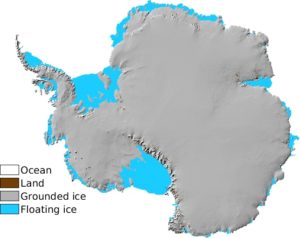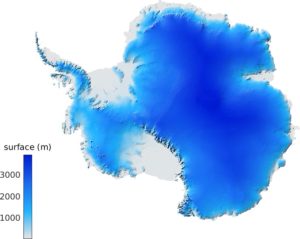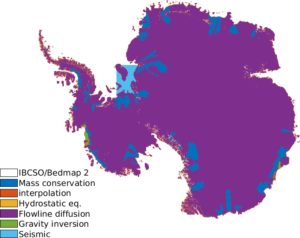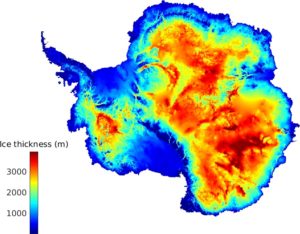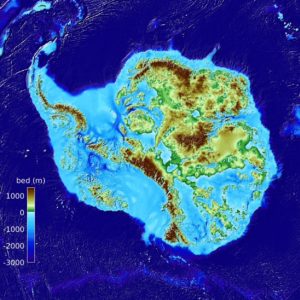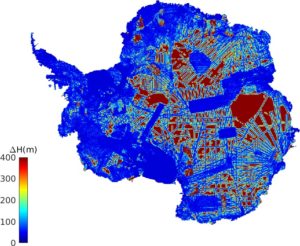BedMachine Antarctica v2
Since 2014, we have been working on a self-consistent dataset of the Antarctic Ice Sheet based on the conservation of mass that is now freely available at NSIDC.
Note: keep in mind that not all of the bed is mapped using mass conservation (MC). If there is a fast flowing region that is currently not mapped with MC, let me know and I will try to add it in the next release. If you have ice thickness data that is not included, I would also be more than happy to add it to the mapping to further improve the topography.
Description
The data are in one single file in NetCDF format (795 Mb) and all heights are in meters above mean sea level (the geoid used is provided in the NetCDF file). All the data use the same 450 m-resolution grid although the “true” resolution of the bedrock may vary depending on the method used to map the bed. This dataset uses data from 1993 to 2016 and has a nominal date of 2012 (same as REMA).
For the hydrostatic equilibrium calculation, we used a density of ice ρice=917 kg/m3, and an ocean water density of ρocean=1027 kg/m3 (following the densities used in Griggs & Bamber 2011 and Chuter & Bamber 2015).
As any model output, there are errors in these maps (there is an estimate included in the dataset). Feedback is more than welcome.
Citation
Morlighem, M., Rignot, E., Binder, T. et al. Deep glacial troughs and stabilizing ridges unveiled beneath the margins of the Antarctic ice sheet. Nature Geoscience 13, 132–137 (2020)
Disclaimer
The ice thickness and bed topography are model outputs and are not free of error (especially in regions where ice thickness measurements are sparse). This dataset is a work in progress and we encourage users to send us feedback so that we keep improving it.
Projection
The projection is Polar Stereographic South (71ºS, 0ºE), which corresponds to ESPG 3031
Reading with MATLAB
MATLAB now has an extensive library for NetCDF files.
filename = 'BedMachineAntarctica-2019-09-04.nc';
x = ncread(filename,'x');
y = ncread(filename,'y');
bed = ncread(filename,'bed')'; %Do not forget to transpose (MATLAB is column oriented)
%Display bed elevation
imagesc(x,y,bed); axis xy equal; caxis([-1000 3000]);
Converting heights to WGS84
All heights are referenced to mean sea level (using the geoid EIGEN-6C4). To convert the heights to heights referenced to the WGS84 ellipsoid, simply add the geoid height:
\(z_{ellipsoid}=z_{geoid} + geoid\)
Surface height and firn depth correction
All the quantities provided in BedMachine are in ice equivalent. This affects primarily the upper surface of the ice, to which we have subtracted a firn depth correction to account for the presence of air in the firn layer. The ice thickness is also in ice equivalent. To recover the top of the surface dem from RAME in WGS84:
\(z_{REMA}= surface + firn + geoid\)
where “firn” is the firn depth correction, “surface” is the surface height, and “geoid” is the geoid height. All these quantities are provided in the netCDF file.
Acknowledgements and References
This project is performed at the University of California Irvine under a contract with the National Aeronautics and Space Administration (Sea Level Rise Program #NNX14AN03G and MEaSURES-3) and the National Science Foundation (Thwaites #1739031).
The ice thickness data are from:
- Gogineni, P. CReSIS RDS Data (from 2002 to 2017); freely available here http://data.cresis.ku.edu/.
- more to come…
The bathymetry data are from:
- …
The surface velocity data used by MC are from:
- …
The surface mass balance is from RACMO 2.3 1 km:
- …
The surface topography map is from:
- REMA
The mask is derived from:
- …
